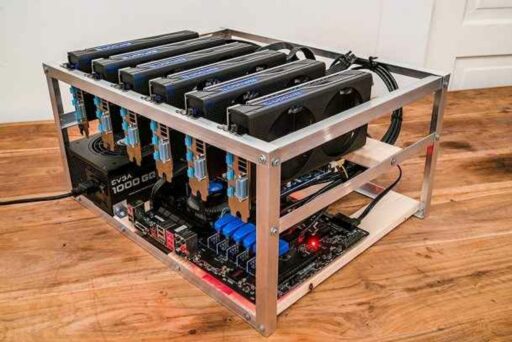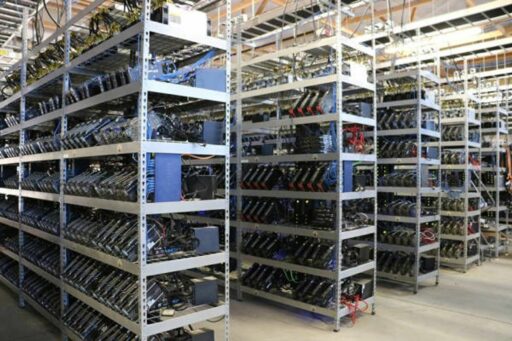Embarking on the crypto mining adventure can be a thrilling and lucrative endeavor. This beginner’s guide is designed to walk you through crafting your ultimate crypto mining setup. From selecting the right mining pool and hardware to understanding ASIC mining and maintaining your equipment, we cover all the essentials to get you started on a successful mining journey. Embrace the ethos of the cryptocurrency world and let’s dive into the complexities of creating an efficient and effective mining operation.
Key Takeaways
- Selecting the right mining pool and hardware, such as CGMiner or BFGMiner, is critical for optimal mining performance.
- Understanding the role of ASIC miners and how to troubleshoot common issues can save on repair costs and improve efficiency.
- Monitoring key performance indicators and conducting routine maintenance are essential for the longevity of mining operations.
- Before starting, evaluate the profitability of Bitcoin mining and understand the impact of price volatility and technical requirements.
- A step-by-step ASIC repair process, including workspace setup and navigating repairs, can transform setbacks into learning opportunities.
Setting Up Your Miner

Choosing the Right Mining Pool
When venturing into Bitcoin mining, selecting the right mining pool is a critical step. Mining pools allow miners to combine their computational power and share the rewards. This collaboration can lead to more consistent earnings than solo mining, but it’s important to choose a pool that aligns with your goals and values.
Here are some factors to consider when choosing a mining pool:
- Reputation and reliability of the pool
- Fee structure and payout policy
- Pool size and total hash rate
- Location and server connectivity
- User interface and support
Remember, the pool you choose can significantly impact your mining profitability and experience. It’s essential to research and compare different pools before making a decision.
According to a recent title, the 10 BEST Bitcoin Mining Pools in 2024 include Slush Pool, F2Pool, AntPool, ViaBTC, BTC.com, Poolin, Genesis Mining, Bitfury, Binance Pool, KanoPool, and PEGA Pool. Each pool has its unique features and comparison metrics that should be carefully evaluated.
Selecting Mining Hardware and Software
When embarking on your crypto mining journey, selecting the right hardware and software is a pivotal step that can significantly impact your mining operation’s success. The market offers a variety of mining hardware, each with its own set of specifications and performance metrics. It’s essential to balance factors such as price, hash rate, and power efficiency to find the best fit for your mining goals and budget.
Here are some popular software options for Bitcoin mining:
- CGMiner: Known for its versatility and support for multiple types of hardware.
- BFGMiner: Offers advanced features and is designed for ASICs and FPGAs.
- BitMinter: User-friendly and works well with the BitMinter mining pool.
Proper setup of your mining hardware and software ensures optimal performance and efficiency. It’s crucial to monitor hardware performance continuously and provide adequate ventilation and power supply to maintain uninterrupted mining operations.
When considering the purchase of mining hardware, it’s important to conduct thorough research and compare the options available. Look for reviews, performance tests, and user experiences to guide your decision-making process.
Optimizing Performance and Efficiency
To achieve the pinnacle of crypto mining efficiency, it’s essential to focus on both the hardware’s energy consumption and its hashing power. The goal is to find a balance where the electricity cost is justified by the mining output. Here are some key points to consider:
- Energy Efficiency: Assess the energy usage of various mining rigs and weigh them against their hashing capabilities.
- Cooling Systems: Implement a robust cooling solution to prevent hardware overheating and maintain consistent performance.
- Firmware Updates: Regularly update your miner’s firmware to enhance performance and security.
Remember, the efficiency of your mining operation is not solely dependent on the hardware. It’s a combination of the right equipment, maintenance, and operational strategies.
While initial costs are a factor, don’t let price alone guide your decisions. Opt for hardware that offers a good balance between cost and long-term profitability. A higher hash rate is desirable, but not at the expense of significantly increased energy consumption.
Understanding ASIC Mining and Common Failures

The Role of ASIC Miners in Crypto Mining
ASIC miners, or Application-Specific Integrated Circuits, are the backbone of modern cryptocurrency mining. Unlike CPUs or GPUs, these devices are engineered specifically for mining. They excel in processing the complex algorithms required to mine digital currencies like Bitcoin, offering unparalleled efficiency and speed.
The introduction of ASIC miners has revolutionized the mining landscape. Here’s a quick comparison of ASICs to their predecessors:
- Processing Power: ASICs provide superior processing power tailored to the mining algorithm.
- Energy Efficiency: They consume less power per unit of work, reducing electricity costs.
- Profitability: Higher efficiency and lower operational costs lead to increased profitability for miners.
Embracing ASIC technology is essential for anyone serious about crypto mining. It represents a significant investment, but the potential rewards justify the cost for many. However, it’s crucial to understand the common failures and maintenance requirements to ensure long-term success.
Identifying and Troubleshooting Common Issues
When your mining rig encounters problems, it’s crucial to have a step-by-step guide for troubleshooting. Software issues, for example, can range from minor inefficiencies to complete system failures. To address these, begin with basic steps such as restarting the mining software, checking for updates, and verifying configurations. If problems persist, consider advanced techniques like voltage testing or using diagnostic tools such as a digital multimeter.
For more complex issues, the mining community can be an invaluable resource. Online forums and user groups are filled with individuals who have faced similar challenges and can offer practical advice. Remember to document your troubleshooting process meticulously, as this can greatly aid in diagnosing and resolving issues.
Advanced troubleshooting may require a deep understanding of your hardware. Be prepared to invest time in learning about voltage testing, fault location identification, and the use of diagnostic equipment like oscilloscopes and thermal cameras.
DIY ASIC Repair: Tools and Safety
Embarking on the journey of DIY ASIC repair requires a well-equipped toolkit. Essential tools include a soldering iron for delicate connections, a multimeter for electrical testing, and a thermal camera or infrared thermometer to detect overheating components. Precision screwdrivers, ESD protection gear, tweezers, compressed air, and thermal paste are also indispensable for a successful repair job.
When setting up your workspace, prioritize a clean, organized, and static-free environment. Adequate lighting and proper ventilation are key, along with magnification tools to closely inspect small components. Remember, a conducive workspace not only facilitates the repair process but also ensures your safety and the integrity of the ASIC miner.
Safety should be your top priority. Always wear protective gear and ensure that your workspace is free from potential hazards. This proactive approach will help prevent accidents and protect your investment.
By equipping yourself with the right tools and setting up a safe workspace, you’re laying the foundation for effective troubleshooting and repair of your mining hardware, turning setbacks into opportunities for learning and improvement.
Monitoring Performance and Maintenance

Key Performance Indicators for Mining Operations
To run a successful crypto mining operation, it’s essential to monitor specific Key Performance Indicators (KPIs). These metrics provide insights into the health and profitability of your mining activities.
- Hash Rate: The number of calculations your miner can perform per second. A higher hash rate increases your chances of solving the cryptographic puzzles and earning rewards.
- Power Consumption: The amount of electricity your setup uses. It’s directly tied to your operational costs and impacts profitability.
- Efficiency: Measured as the ratio of hash rate to power consumption. Higher efficiency means more hashes per watt of power used.
- Uptime: The time your miner is operational and actively mining. Maximizing uptime is crucial for maximizing potential earnings.
Regularly reviewing these KPIs allows you to make informed decisions about upgrading hardware, optimizing settings, and scaling your operation. Keeping a close eye on these figures can help you stay competitive in the ever-evolving landscape of crypto mining.
Routine Maintenance for Longevity
To ensure the longevity and optimal performance of your ASIC miners, a structured routine maintenance schedule is crucial. Regular check-ups and timely interventions can prevent minor issues from becoming major setbacks. Maintenance routines should include environmental controls, firmware updates, and thorough inspections.
- Environmental Controls: Maintain a stable temperature and humidity level to prevent overheating and moisture damage.
- Inspections: Regularly inspect for dust accumulation, hardware integrity, and electrical connections.
- Firmware Updates: Keep your mining software up-to-date to ensure compatibility and security.
- Maintenance Records: Document all maintenance activities to track the health of your equipment over time.
Adopting a proactive approach to maintenance is not just about fixing problems—it’s about creating an optimal operating environment that prevents issues from arising in the first place. By staying vigilant and addressing issues promptly, you can safeguard your investment and maintain peak mining efficiency.
Ventilation and Power Supply Considerations
Proper ventilation and power supply are critical to the sustainability and safety of your crypto mining setup. Here are some key considerations:
- Temperature Regulation: It’s essential to maintain an optimal operating temperature to prevent overheating. This can be achieved through adequate cooling and air circulation.
- Humidity Control: Keeping humidity levels in check will protect your equipment from corrosion and electrical shorts.
- Dust and Debris Management: Regular cleaning is necessary to prevent blockages in ventilation and cooling systems.
Energy efficiency should be a top priority as it directly impacts profitability. Selecting hardware with a favorable balance between energy consumption and hashing power is crucial.
Remember to schedule routine maintenance checks for critical components such as fans and power supplies. This will not only ensure continuous operation but also help in identifying issues before they escalate.
Important Considerations Before You Start Mining

Evaluating Bitcoin Mining Profitability
Before diving into the world of crypto mining, it’s crucial to assess the potential profitability of your intended setup. This involves a careful examination of various factors that can significantly impact your bottom line.
Electricity costs, hardware expenses, and the ever-fluctuating market price of Bitcoin are key variables to consider. A practical approach is to use crypto mining calculators, which can help you estimate potential earnings based on your hardware’s hash rate, power consumption, and the current market conditions. Remember, these calculators are only as accurate as the data you input, so it’s important to stay informed and adaptable to maintain profitability.
While warranty and availability of mining hardware are important, they pale in comparison to the importance of ongoing performance monitoring and adaptation to market trends.
Here’s a simple table to help you visualize some of the core components of mining profitability:
| Component | Why It Matters |
|---|---|
| Electricity Costs | Major factor in ongoing operational costs |
| Hardware Expenses | Initial investment and maintenance costs |
| Market Price | Directly affects revenue potential |
Understanding the Impact of Bitcoin Price Volatility
The inherent volatility of Bitcoin’s price is a critical factor for anyone considering entering the mining space. Price fluctuations can occur rapidly, significantly affecting the profitability of mining operations. During market upswings, mining can be highly lucrative, but during downturns, miners may face reduced profits or even losses.
Miners must be prepared for the impact of price volatility on their operations and have strategies in place to mitigate risks.
Understanding the dynamics of Bitcoin’s price is essential for making informed decisions about when to expand operations or scale back. Here are some key points to consider:
- The importance of staying informed about market trends and news.
- Developing a risk management strategy to cope with price swings.
- The potential need for financial reserves to weather periods of low profitability.
Additionally, events such as Bitcoin halving, which reduce the mining reward by half, pose sustainability and profitability challenges for miners. These events can shift the balance of mining power and influence the overall economics of the mining industry.
Technical Proficiency and Learning Resources
Embarking on the crypto mining journey requires a certain level of technical proficiency. For beginners, it’s crucial to invest time in learning about the intricacies of mining hardware and software. You can find beginner-friendly resources like online courses, tutorials, and e-books that cover the fundamentals of cryptocurrency mining. Some popular platforms offer structured learning paths that cater to various experience levels, from basic repairs to advanced troubleshooting techniques.
It’s important to assess your experience level honestly. If you’re new to electronic repairs, consider the risks and potential costs involved. For those with some experience, DIY repairs can be a rewarding challenge.
Here are some additional tips to help you along the way:
- Documentation is key. Keep detailed records of your troubleshooting process, including symptoms, tests conducted, and results.
- Leverage community resources. Forums, user groups, and social media platforms are invaluable for advice and solutions.
Remember, if the task seems daunting, professional services are available. They offer expertise, warranty preservation, and comprehensive service, which can be especially beneficial for those less confident in their technical abilities.
Step-by-Step ASIC Repair Process

Preparation and Workspace Setup
Before diving into the step-by-step ASIC repair process, it’s crucial to prepare a conducive workspace that will support your efforts and protect your equipment. A well-prepared workspace is the foundation of successful and safe repairs.
- Adequate Lighting: Essential for spotting small defects and ensuring precision work.
- Clean, Organized Surface: A clutter-free environment with compartments for tools prevents mishaps.
- Static-Free Environment: Utilize ESD-safe materials like an anti-static mat to safeguard sensitive components.
- Ventilation: To mitigate the risks from fumes, ensure good airflow or consider a fume extractor.
- Magnification Tools: A magnifying glass or microscope is invaluable for inspecting minute details.
Equipped with the right tools and a properly set up workspace, you’ll be well-prepared to tackle ASIC miner repairs. This setup not only aids in the repair process itself but also ensures a safe and efficient workflow.
Remember, the goal is to create an environment that is not only functional but also minimizes potential damage to your ASIC miners. By following these guidelines, you’ll be setting yourself up for a more streamlined and effective repair process.
Navigating the Repair Process
Once you’ve diagnosed the issues with your ASIC miner, it’s time to embark on the actual repair. Begin by developing a repair plan that prioritizes the most critical issues. Source the necessary replacement parts, ensuring they are compatible with your ASIC model. Here’s a basic guide to navigating this process:
- Check Compatibility: Ensure the firmware version you plan to install is compatible with your ASIC miner model.
- Prioritize Repairs: Tackle the most significant issues first to restore functionality.
- Source Replacement Parts: Obtain the correct parts for your specific model.
- Outline the Steps: Create a detailed action plan with the required tools and step sequence.
Throughout the repair process, maintain a clean and organized workspace and proceed with caution to avoid causing further damage.
Executing the repair requires a meticulous approach. Use a multimeter to check for circuitry issues and a thermal camera to identify hot spots. Document your findings to facilitate the repair. Remember, a systematic approach is key to a successful ASIC repair.
Transforming Setbacks into Learning Opportunities
When it comes to ASIC repair, adopting a proactive approach is crucial. Embrace the learning curve as you navigate through the complexities of troubleshooting and repairing your mining hardware. Each setback is an opportunity to deepen your understanding and refine your skills.
Implementing a proactive approach to setbacks not only mitigates future issues but also empowers you as a miner.
Engaging with the broader mining community can significantly enhance your learning experience. Sharing challenges and solutions with like-minded individuals accelerates your learning and contributes to the collective knowledge of the community. Remember, the journey of crypto mining is as much about the process as it is about the outcome.
The testing and diagnostic techniques used when repairing ASICs are essential to ensure the thorough repair of any integrated circuits. Below is a list of key techniques to consider:
- Visual inspection for physical damage
- Checking hash boards for functionality
- Firmware updates and factory resets
- Multimeter testing for electrical issues
- Thermal imaging to detect overheating components
Conclusion
As we wrap up our beginner’s guide to crafting the ultimate crypto mining setup, it’s clear that the journey into Bitcoin mining is both challenging and rewarding. From selecting the right hardware and software to understanding the intricacies of ASIC miners and their maintenance, each step is crucial for maximizing profitability and efficiency. This guide has aimed to equip you with the foundational knowledge needed to navigate the complexities of crypto mining. Remember, the key to success lies in continuous learning, meticulous planning, and the willingness to adapt to the ever-evolving landscape of cryptocurrency. Embrace the ethos of innovation and self-reliance, and you may find that mining becomes more than just a venture—it becomes a testament to your pioneering spirit in the digital frontier.
Frequently Asked Questions
What is the best Bitcoin mining hardware currently available?
The best Bitcoin mining hardware is subjective and depends on factors like budget, electricity cost, and desired hash rate. Popular options include ASIC miners like the Bitmain Antminer series, WhatsMiner M50, and other high-efficiency models.
How do I choose the right mining pool for my setup?
Choosing the right mining pool involves considering factors such as pool fees, payment schemes, server location, and the pool’s reputation. It’s important to select a pool that aligns with your goals and has a consistent track record.
What are some common issues with ASIC miners and how can I troubleshoot them?
Common issues with ASIC miners include overheating, hardware failures, and connectivity problems. Troubleshooting can involve checking power supplies, cooling systems, and ensuring firmware is up to date. For more complex issues, consult the manufacturer’s guidelines or seek professional repair services.
What routine maintenance should I perform on my mining hardware?
Routine maintenance for mining hardware includes cleaning dust and debris, checking and replacing fans, updating firmware, and monitoring hardware temperatures to prevent overheating. Regular check-ups can prolong the lifespan of your equipment.
How does Bitcoin price volatility affect mining profitability?
Bitcoin price volatility can significantly impact mining profitability. When prices are high, mining rewards are more valuable, but when prices drop, the same rewards may not cover operational costs. Miners must be prepared for these fluctuations and adjust their strategies accordingly.
What are the key performance indicators (KPIs) I should monitor in my mining operation?
Key performance indicators for mining operations include hash rate, power consumption, hardware efficiency, pool contribution, and overall profitability. Monitoring these KPIs helps optimize performance and ensure the mining setup is running effectively.





